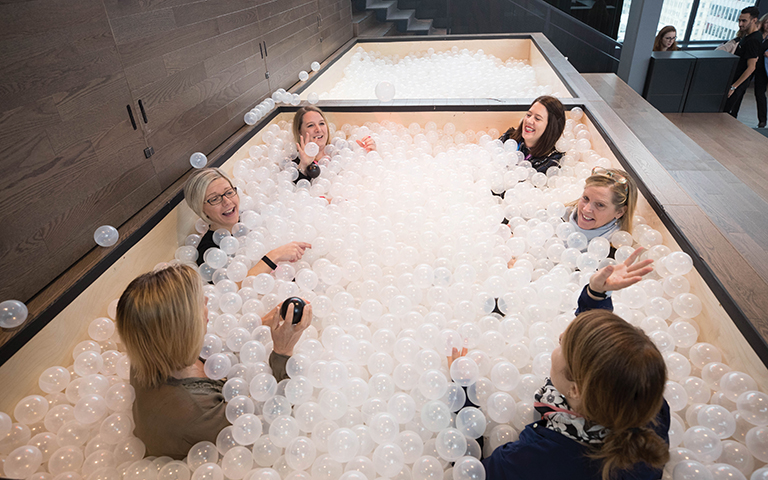
C2 MTL — now known as C2 Montréal — was launched seven years ago, sparked by the desire of two friends, Jean-Francois Bouchard, co-founder of the Montréal-based Sid Lee creative agency, and Daniel Lamarre, CEO of the Cirque du Soleil entertainment company, to reimagine business meetings. They wanted, Bouchard later said, to invent a new form that would challenge the typical attendee experience — hours spent sitting in rows of chairs in featureless hotel ballrooms watching PowerPoint slides — and help business leaders integrate creativity and innovation into their organizations.
Since then, working as a nonprofit under the conference tagline Creativity + Commerce, C2’s organizers have succeeded in capturing both global attendance and the world’s attention — the 2018 conference, held May 23–25, brought more than 7,000 attendees from 60 countries to Montréal. Beginning in 2013, C2 Montréal has been held in the Arsenal, an industrial art exhibition space, where, over the years, the perennially sold-out three-day conference has set new standards for immersive experiences. Among the ingredients that created the 2018 experience in Montréal were:
Under a tent, in a container, on the water

This year’s panels and talks — which juxtaposed such diverse voices as the rapper and entrepreneur Snoop Dogg; His Excellency Omar Bin Sultan Al Olama, the United Arab Emirates minister of state for Artificial Intelligence; and Sylvia Earle, the first female chief scientist of the National Oceanic and Atmospheric Administration — were presented in a 1,600-seat “Big Top,” a tented theatrical pavilion equipped with 360-degree surround video projection and sound. The tent, set up in Arsenal’s big backyard, was surrounded by food trucks, sponsor lounges tucked into shipping containers stacked three stories high, and collaborative sessions, including some held aboard boats on the adjacent canal. Inside, attendees participated in more collaborative sessions, including one designed around baking cookies, an augmented-reality-enhanced session which featured Technicolor-hued feathered masks, and “conversation markets,” which projected discs of colored light onto the floor to guide participants through a series of topical questions.
Moving parts
Participants entered the conference by walking across a mechanism that almost imperceptibly rotated the floor beneath their feet. Once inside, those who stepped up to a circular food-and-beverage bar to buy a pastry or sandwich found themselves rotating around the counter.
“Each year, we design something at the entrance that will, a little bit, reset the minds of people who enter the event,” said Génifère Legrand, C2’s chief creative officer. “It’s our way to say, ‘Hey, now you’re about to live something. Be there. Be present. Forget about your work issues.’” The moving floor, she added, “was a metaphor for the transformation that’s surrounding us — sometimes you can barely feel it, but it’s happening. And it’s happening faster than we can realize it.”
Extending the Brand
The rate of change in the world is matched by a demand for new, more experiential and collaborative ways to meet. Almost as soon as C2 got underway in 2012, organizers began to field questions about how the conference could be replicated and extended beyond just three days in May in Montréal, said Richard St-Pierre, president of C2 Montréal and C2 International. “People came to us saying they loved the vibe and the experience,” he said, but asked, “‘What happens for the other 362 days out of the year?’ Hotels came to us and said, ‘You know what you’re creating in Montréal? Could you do this in our hotel?’”
Part of the answer to that question lays in the creation of conferences in other cities — C2 Melbourne debuted last year and will return again in October, and is the first step of a plan to create a global network of C2-branded conferences. Another part of answer can be found on the 21st floor of the Fairmont Queen Elizabeth in Montréal, where a partnership between C2 and the hotel has established the first C2-branded permanent meeting space, Espace C2.
Not a ‘Narrow View’

The 13,000-square-foot space, which includes a rooftop terrace, is part of a top-to-bottom renovation of the 60-year-old downtown Montréal hotel. The modern and modular meeting space is stunning, with floor-to-ceiling windows on four sides that afford views of Montréal’s skyline, and is equipped the latest in lighting and sound.
But you will miss the point of the space if you concentrate only on its look and feel, St-Pierre said. “The point is not to have a bigger and better room, or a higher-definition LCD screen,” he said. “Everybody thinks, ‘Oh, hotel [meeting] rooms are boring, so we need to reinvent them.’ But that’s kind of a narrow view of what’s really happening.”
The true design focus of the new space is the humans who will use it. The guiding question was: What is the purpose of the space that will be created? St-Pierre said. “The space wasn’t designed because people are tired of beige and gray hotel meeting rooms. It was designed to create dialogue between people.”

To that end, organizations and corporations not only can book the space, but can contract for C2-branded customized workshops, labs, and brainstorming sessions, facilitated by C2 staff. That includes experiences that debuted at C2 Montréal, such as “ball pools” where participants converse, not around cocktail rounds, but in big vats filled with small plastic balls.
As regional director of sales and marketing for the Fairmont Queen Elizabeth, Anne Marie Johns oversees the promotion and sales of the new meeting space, and during construction, Johns consulted with the architects and designers to make sure that their concepts would work for meeting planners from the delivery and programming aspect. But Johns has also experienced the space from the other side — as a participant in an executive leadership meeting, which brought together seven executive committees from seven hotels.
And from that point of view, Johns wasn’t quite sure about what she would gain from some of the activities, like climbing with colleagues into a pool filled with hundreds of balls. “I am thinking as an outsider, ‘What kind of output is going to come in here?’” Johns said. But then “when you are actually immersed in them with your colleagues,” she said, “what happens is that it puts everyone at the same level. Forget about the hierarchy of the company — you’re all sitting there in this funny ball pool with an interesting sensation. And then, all of a sudden, everyone is giggling and laughing. It brings a bit of fun and a relaxed approach to the discussions that are programmed into your event.”
How participants get to that relaxed state is a bit counterintuitive. “In the experiences that we are designing, it’s very important that it starts with something that is not that comfortable so everybody shares an experience together,” Legrand said. “They have something in common. They are all in a weird place doing something that is not usual, so they can connect more easily together. But once they are in the part of the conversation, all of our environments are super comfortable so they feel faith in one another and they can truly engage.”
Creating a Dialogue

There is so much disruption and change for companies today, Johns said. “For the way I manage today, collaboration is key right now,” she said. “No one has the million dollar solution anymore — it takes collaborative environments.”
Over the last year, C2 has organized approximately 20 corporate events around the world and all have shared, St-Pierre said, a common thread: Organizations and industries are grappling with transformation and disruption, but who has the answers?
“You can read articles talking about how industries are being disrupted, but there is no one person who can figure out what is the answer for this industry or for that industry.” When C2 designs content, it’s “not to give the answers, but to assemble the right people with the right content,” St- Pierre said. “We create environments that will help people figure out the answers from themselves.”
One example is the Movin’ On conference on global sustainable mobility (think vehicles and transportation systems), which was designed by C2 and held at the Arsenal a week after the C2 Montréal conference. Although there may be agreement that sustainable mobility is the future, “nobody knows what the impact of that is for the tire industry, for the fuel industry, or for the airline industry,” St-Pierre said.
The summit brought together industry experts, academics, and policy makers from those industries to participate in labs and workshops with the goal of finding concrete solutions. “Participants figure out amongst themselves what [sustainable mobility] means for them. And that means that when they go back to their office, they’re not only inspired, but they actually have a to-do list.”
“Our services,” Legrand said, “basically are to design immersive environments and experiences that connect people to one other, and help them be more creative, to pursue new ideas.” Her teams adapt content into the context of what organizations want to achieve, she said. “It’s customized, for sure. We make sure that we’re suggesting the experiences that will help them achieve their goals, that will help them to have participants, their clients, or their employees engage together and be able to take action at the end of the event.”
Our purpose was really to propel the economy and society forward.
C2 did not start out saying, “We’re going to be a better event company than the others out there,” St-Pierre added. “Our purpose was really to propel the economy and society forward.” If that sounds like a broad stroke, he said, “we actually measure what I’ve just said.” An outside firm surveys participants six months after an event and asks: Did you strike a deal? Did you hire people? Did you get new investment? “Year after year, the number of deals grows significantly. Last year, business generated as reported by C2 Montréal attendees totaled more than $700 million,” he said. In Montréal, there were close to 2,000 jobs created in 72 hours.
“When you look at most conferences and spaces, everything — money, effort, time — is dedicated to what is happening on the stage,” St-Pierre said. “We twist it the other way. The people in the room are what makes the space come alive, and the stage is just a tool for this to happen,” he said.
“I’ve been talking about C2 for the past seven years, and I’ve been telling our recipe. It is quite simple: Shift the focus from the stage to the audience, the participants themselves and have the participants create a dialogue amongst themselves,” he said. “If you just do those two things, you will have understood 95 percent of C2.”
Where in the World is C2?
C2 International announced in May that it has signed a 10-year-long contract with the Melbourne Convention and Exposition Center (MCEC) in Melbourne, Australia, to offer C2-branded collaborative experiences to MCEC clients.
Eventually, C2 plans to build a global network of convention centers that offer branded C2 spaces, C2 President Richard St-Pierre said. C2 currently is talking to multiple centers, St-Pierre said, and aims to offer the spaces at between 15 and 20 large-scale convention centers ranging from .5 million to 1.5 million square feet, within the next three to four years.
In addition to C2 Montréal and C2 Melbourne, C2 plans new conferences in Europe, Latin America, and the Middle East, he said. Sometime in the next three to four years, “we’ll be able to say that there are five C2s, happening basically every six weeks somewhere in the world.
This momentum never stops.
“One of our goals, by having all those venues around the world, both permanent and temporary, is actually that this momentum never stops,” St-Pierre said.
For more on C2, read our story, “9 Hospitality Game-Changers.”


